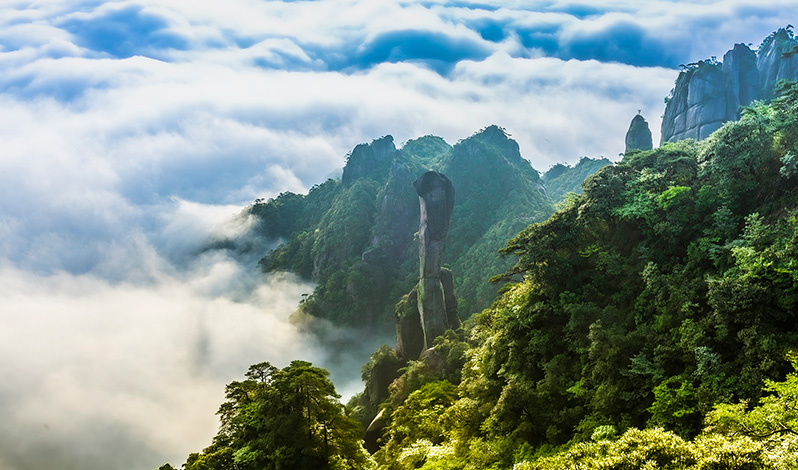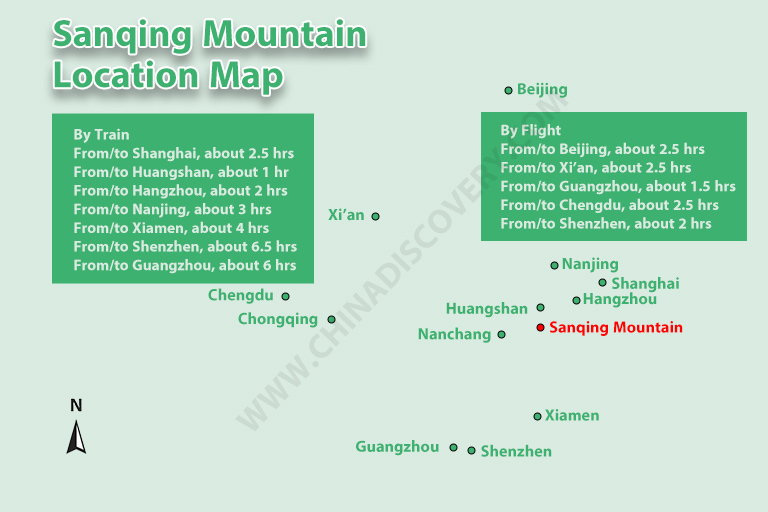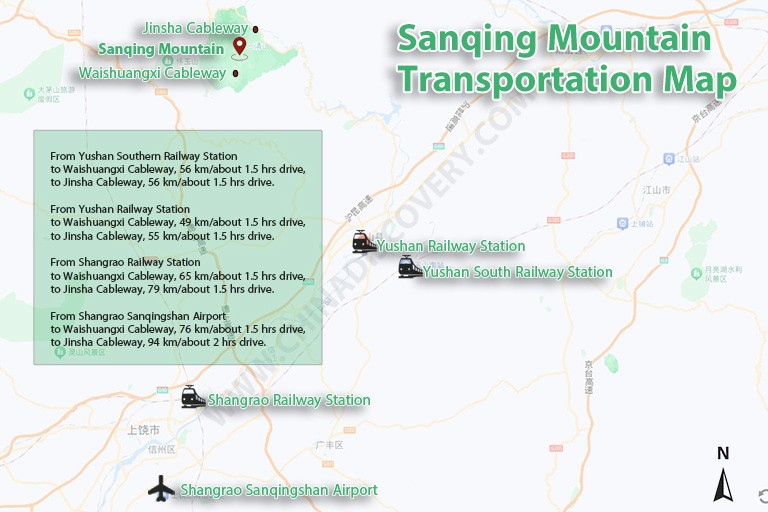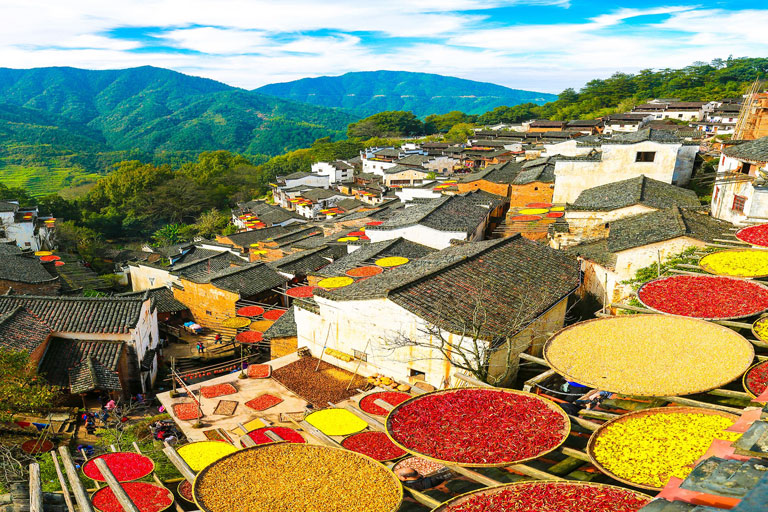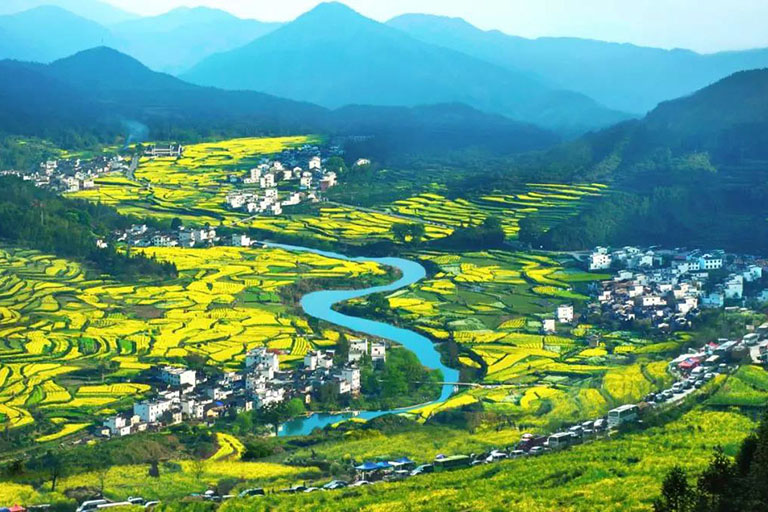More Than the "Little Yellow Mountain"
Sanqing Mountain (Sanqingshan) is called Little Yellow Mountain (Huangshan) by many people mainly because its geomorphological features are similar to those of Yellow Mountain, especially peaks, rock formations, and natural scenery.
Yellow Mountain is famous for its odd-shaped pines, spectacular rocky peaks, sea of clouds, and hot springs, while Sanqing Mountain also has similar natural landscapes. After hundreds of millions of years of weathering and erosion, the granite peaks and forests have formed, which are strikingly similar to the pine and stone landscapes of Yellow Mountain.
It is worth mentioning that Sanqing Mountain still maintains its unique geographical features. Its pathway is not as steep as that of Yellow Mountain, so it is easy to climb. It features its greenery and long trestles. In spring, different kinds of azaleas are blooming along the pathway, feasting tourists’ eyes.
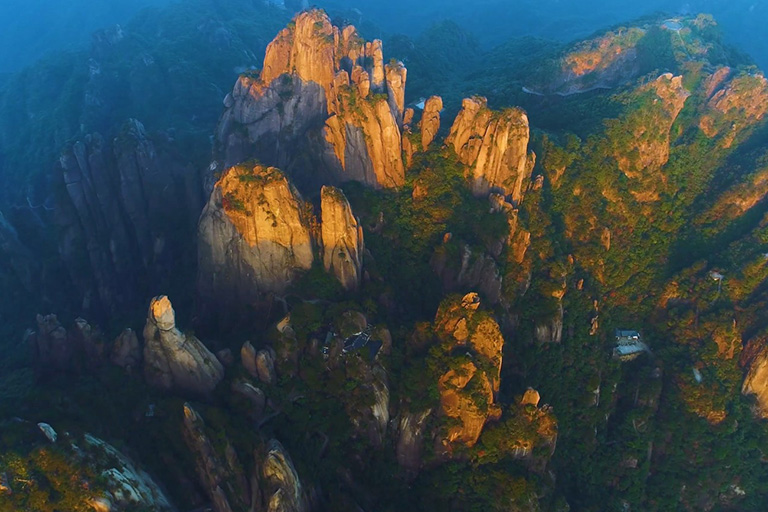 Bird View of Sanqing Mountain
Bird View of Sanqing Mountain
©三清山官网(sqsfjq.com)
Why Sanqing Mountain (Sanqingshan) is a Taoist Sacred Mountain?
Sanqing Mountain has three major peaks, namely Yujing Peak (玉京峰), Yuxu Peak(玉虚峰), and Yuhua Peak (玉华峰), which resemble the Taoist Trinity, Yu Qing (玉清), Shang Qing (上清), and Tai Qing (太清). That’s why people call the mountain “Sanqing” which means “three pure ones”. The highest peak, Yujing Peak, is at an elevation of 1819.9 meters. The mountain is characterized by spectacular rock formations, with 48 granite peaks and 89 granite pillars.
Taoism on Sanqing Mountain began in the Jin Dynasty Ge Hong (葛洪) . According to historical records, Ge Hong and Li Shangshu (李尚书) made alchemy, preached Taoist doctrines, and wrote books in Sanqing Mountain during the Eastern Jin Dynasty (357-361). There remains the site of Dan Well dug by Ge Hong which is still not dry till now. It is renowned as the “Immortal Well” for its clear, sweet, and magical water. Thus, Ge Hong became the founding father of Sanqing Mountain.
Taoism in Sanqing Mountain flourished during the Tang Dynasty. Taoist visitors came in an endless stream to Sanqing Mountain. Taoist priests built the first Taoist architecture on the mountain - Sanqing Blessed Land (三清福地). The Ming dynasty was the heyday of Taoist activity, and Taoist buildings sprang up on the mountains.
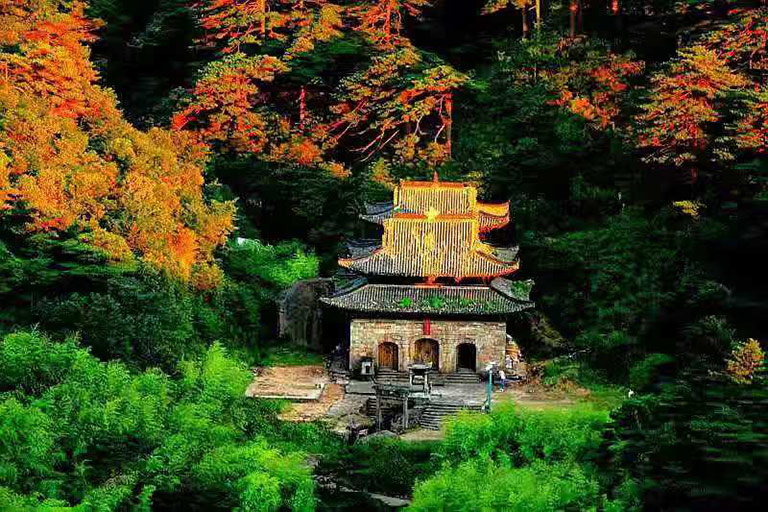 Sanqing Temple
Sanqing Temple
©三清山官网(sqsfjq.com)
Why Enjoy a Resort Vacation in Sanqing Mountain (Sanqingshan)?
Sanqing Mountain is an ideal place to spend a vacation. Compared with other popular destinations, Sanqing Mountain has an intact and well-protected ecosystem because it was developed lately. Immersing in the tranquil atmosphere, tourists can escape from the bustling life and breathe the fresh air, appreciating strange stones, crystal waterfalls, ancient pines, colorful azaleas, and various Taoist buildings.
With convenient transportation, tourists have easy access to Sanqing Mountain. There is also comfortable accommodation near the scenic area. Luxurious five-star hotels are available with wonderful facilities. For example, Hilton Sanqingshan Resort Hotel is recommended due to its short distances to the Waishuangxi Cableway, beautiful mountain view, and considerate service.
 Hilton Sanqingshan Resort Hotel
Hilton Sanqingshan Resort Hotel
©希尔顿官网(hilton.com.cn)
Main Scenic Area in Sanqing Mountain
There are 10 scenic areas in Sanqing Mountain in total. Among them, two scenic areas are must-visit. They are the Nanqing Park Scenic Area (南清园景区) and the West Coast Scenic Area (西海岸景区).
Nanqing Park Scenic Area
It is at the center of Sanqing Mountain and the core scenic area, demonstrating the granite peaks formed more than one billion years ago by geological evolution. Landmarks like Oriental Godness (东方女神) and Giant Boa (巨蟒出山) are here waiting for tourists to explore. Liuxia Tarrace (浏霞台) and Jade Tarrace (玉台) are ideal places to appreciate sunrise, sunset, and sea of clouds.
West Coast Scenic Area
It is at the western part of Sanqing Mountain with the highest and longest trestle circling the mountain. Tourists can enjoy deep canyons, ancient pine trees, the magnificent sea of clouds, etc.
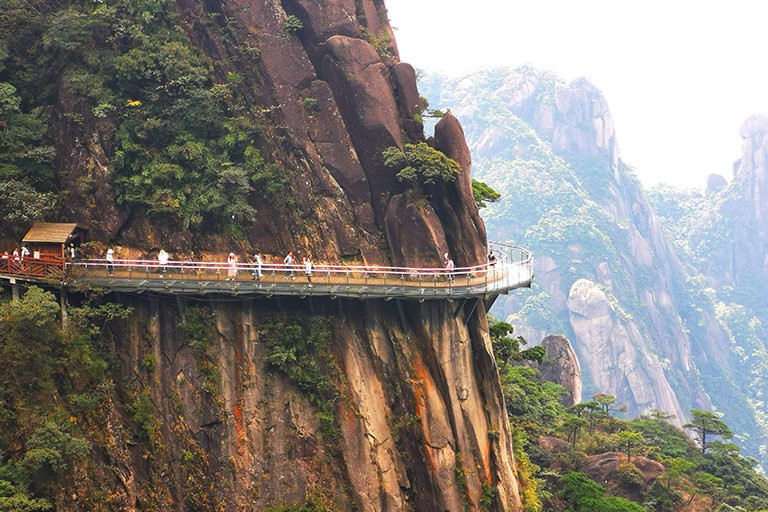 Trestle on Sanqing Mountain
Trestle on Sanqing Mountain
©三清山官网(sqsfjq.com)
Must-see Attractions in Sanqing Mountain (Sanqingshan)
Oriental Godness (东方女神)
Oriental Goddess is located in the northeastern part of the Nanqing Park Scenic Area and a landmark of Sanqing Mountain. With an elevation of more than 1180 meters, the stone is like a young girl with long hair draped over her shoulders. For hundreds of millions of years, the goddess sat on the peak with a peaceful demeanor, silently watching all living things. Legend has it that the goddess is the twenty-third daughter of the Queen Mother of the West, named Yao Ji. People believe that she is the embodiment of spring, and therefore called the “Oriental Goddess”.
Giant Boa (巨蟒出山)
Giant Boa is located in the northern part of the Nanqing Park Scenic Area, which is the iconic landscape of Sanqing Mountain. It is formed by weathering and gravity disintegration. The granite peak has several transverse cracks, but after hundreds of millions of years of wind and rain, it is still standing. The peak has a flat top and a thin neck. The thinnest part is only about 7 meters in diameter. It looks like a huge boa out of the mountain that wants to go up in the air.
Immortal Showing the Way (仙人指路)
Immortal Showing the Way is about 1.5 meters high and 0.6 meters in diameter. It resembles a slim finger pointing to the sky as if it were pointing out a road to become immortal, hence the name. It was formed when the granite peak column was subject to differential weathering.
The Monkey King Appreciating Treasure (猴王观宝)
The granite boulder looks like a monkey king holding a piece of treasure and sitting alone on the summit. It is approximately 7 meters high and has a diameter of around 4 meters. It was formed because the granite body was cut by fractures and was further subjected to gravitational collapse, spheroidal weathering, etc.
Sanqing Temple (三清宫)
Sanqing Temple is located in the northeast corner of Sanqing Mountain. The temple is enshrined with statues of Yu Qing, Shang Qing, and Tai Qing. Outside the temple, there are a total of 260 ancient relics including temples, springs, pools, and towers. These ancient buildings and stone carvings are elaborately arranged according to the pattern of a Bagua, which is an invaluable site for the study of ancient Taoist architectural layouts in China.
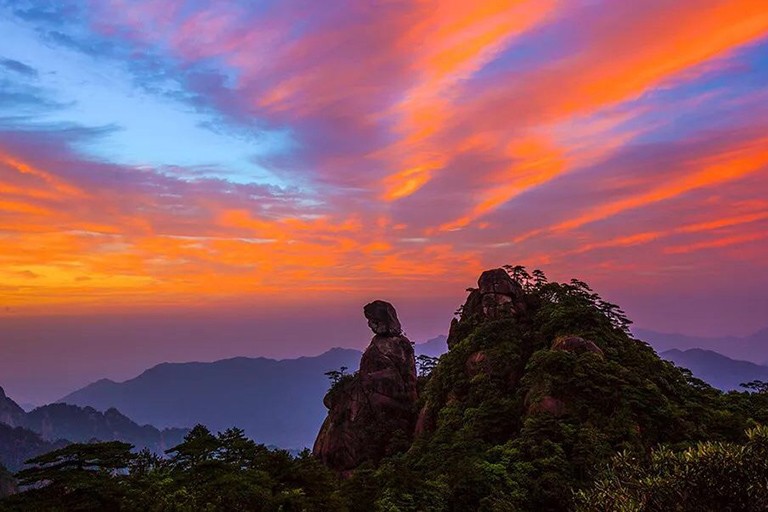 Oriental Godness
Oriental Godness
©三清山官网(sqsfjq.com)
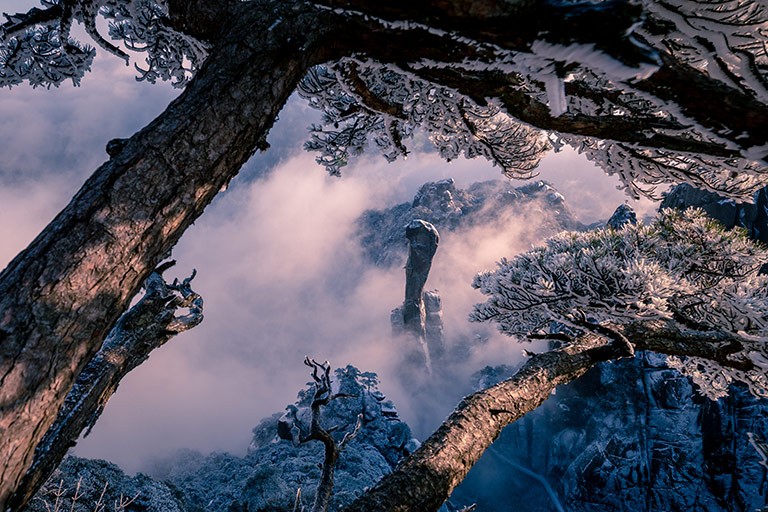 Giant Boa
Giant Boa
©三清山官网(sqsfjq.com)
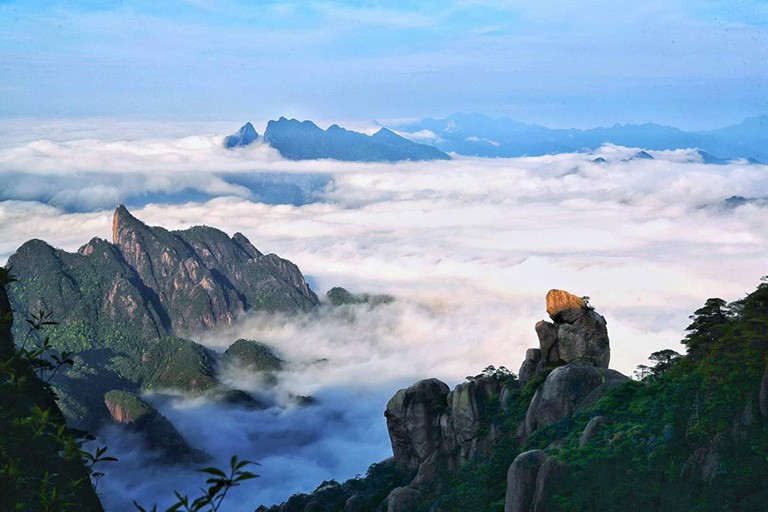 The Monkey King Appreciating Treasure
The Monkey King Appreciating Treasure
©三清山官网(sqsfjq.com)
Recommended Routes on Sanqing Mountain (Sanqingshan)
Minor Circle Route (about 2 hrs)
Jinsha Cableway – Giant Boa (巨蟒出山) – Penguin Offering Peach (企鹅献桃) – Oriental Godness (东方女神) – Jinsha Cableway
Middle Circle Route (about 5 hrs)
Jinsha Cableway – Giant Boa – Penguin Offering Peach - Oriental Godness – Azalea Valley (杜鹃谷) – Jade Terrace – Young Lady with Open Arms (玉女开怀) – A Ray of Sky (一线天) – Immortal Drying Shoes (仙姑晒鞋) – Yuhuang Peak (禹皇顶)– Fox Eating Chicken (狐狸啃鸡) – Jinsha Cableway
Large Circle Route (about 7 hrs)
Jinsha Cableway – Giant Boa – Penguin Offering Peach - Oriental Godness - Azalea Valley – Jade Terrace – Young Lady with Open Arms – Rishang Platform (日上平台) – West Coast Trestle (西海岸栈道) – Yusonglin (郁松林) – Sunshine Coast Trestle (阳光海岸高空栈道)– Yuhuang Peak–Fox Eating Chicken - Jinsha Cableway
The minor circle route is suitable for all travelers including kids and seniors. Most of the part is the flat pathway which is energy-saving and easy to hike, while the large circle route is designed for experienced hikers which is challenging and includes more attractions. Tourists can choose different routes according to physical condition, time, and interests. Please note that the large circle route includes the attractions of the middle circle route, and the middle circle route includes the attractions of the minor circle route. If you need a tailor-made route for hiking, please feel free to contact us!
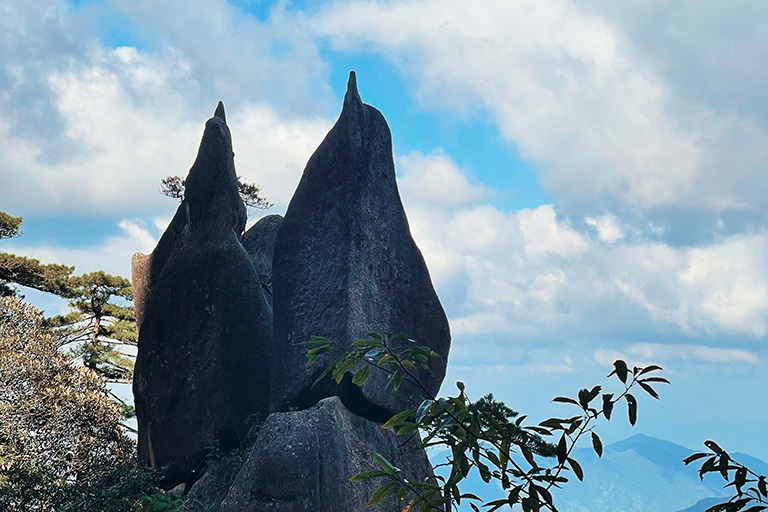 Penguin Offering Peach
Penguin Offering Peach
©三清山官网(sqsfjq.com)
Sanqing Mountain Weather & Best Time to Go & What to Wear
Sanqing Mountain belongs to a subtropical monsoon climate with distinctive four seasons. The best time to visit Sanqing Mountain is spring (Mar. to May), summer (Jun. to Aug.), and autumn (Sept. to Jan.).
Azaleas spread all over the mountain in spring and early summer. Tourists who come during spring can appreciate different kinds of azaleas blooming. It is recommended to wear thin coats or windbreakers to keep warm and comfortable.
In summer, it is not hot as the average temperature is 21℃ in July. It’s suitable to spend a summer vacation here to enjoy the greenish and lush mountains. T-shirts and shorts are suitable for the weather. Umbrella, sunglasses, and sunscreen should be prepared during your vacation.
In autumn, it is dry and cool, giving tourists a favor to hike and camp. Sport suits will be a good choice for the hiking tour.
In winter, snow will cover the mountain for a short time, wearing a white coat for it. Please note the road will be slippery during winter. Non-slip sports shoes can help a lot for winter visits.
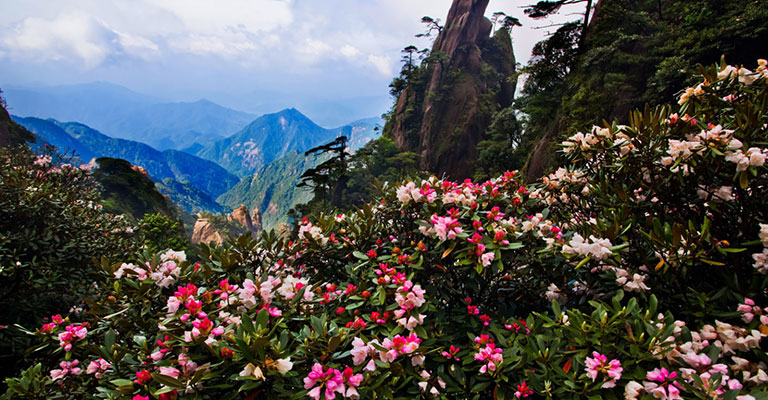 Azaleas on Sanqing Mountain
Azaleas on Sanqing Mountain
©三清山官网(sqsfjq.com)
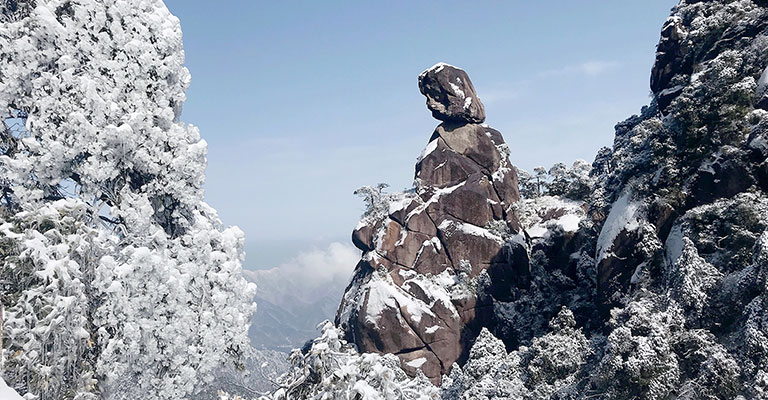 Oriental Godness in Winter
Oriental Godness in Winter
©三清山官网(sqsfjq.com)
Where & How to Get to Sanqing Mountain (Sanqingshan)
Sanqing Mountain is located at the junction of Yushan County and Dexing County in Shangrao City, Jiangxi Province. Though Shangrao City is not large, it has convenient public transportation which gives tourists easy access to Sanqing Mountain. Tourists can visit larger cities in China and then take a flight to Shangrao Sanqingshan Airport or take a train to Shangrao Railway Station, Yushan Southern Railway Station, and Yushan Railway Station. Shangrao Railway Station and Yushan Southern Railway Station have high-speed trains, while Yushan Railway Station only runs normal trains.
By Flight
Shangrao Sanqingshan Airport has flights from/to Beijing (about 2.5 hrs), Xi’an (about 2.5 hrs), Guangzhou (about 1.5 hrs), Chengdu (about 2.5 hrs), Shenzhen (about 2 hrs), etc.
By Train
High-speed trains are convenient to travel from/to Shanghai (about 2.5 hrs), Huangshan (about 1 hr), Hangzhou (about 2 hrs), Nanjing (about 3 hrs), Xiamen (about 4 hrs), Shenzhen (about 6.5 hrs), Guangzhou (about 6 hrs).
After arriving at Shangrao City, tourists are supposed to take a taxi or bus proceeding to Sanqing Mountain. Two cableways can ascend Sanqing Mountain, namely Waishuangxi Cableway (Northern Cableway) and Jinsha Cableway (Eastern Cableway). Tourists can check the required time and distance of the cableway on our Sanqing Mountain transportation map.
Sanqing Mountain (Sanqingshan) Tickets & Fee
The fee for entrance and cableway varies according to age and occupation. For normal adults, it charges a full price, while for students, kids (between 1.2 meters and 1.5 meters high), and seniors (aged between 60 and 64 years old), it charges half price. It is free for Kids below 1.2 meters and seniors older than 65 years old.
Entrance Fee: 120 CNY/Adult, 60 CNY/Student & Kid & Senior (valid for 2 days)
Cableway Fee : Round-trip Ticket - 125 CNY; Ascending Ticket - 70 CNY; Descending Ticket - 55 CNY. Please note that Cableway runs from 7:30 to 17:30. (valid for 1 day, apply to both Jinsha and Waishuangxi)
Where to Stay in Sanqing Mountain(Sanqingshan)
Tourists can choose to stay on the mountain or live at the bottom of the mountain according to their needs and time. Tourists can find various hotels of different levels in and around Sanqing Mountain. It is recommended to live in the scenic area for 1 night at least since it is worth it to appreciate the sunrise on Sanqing Mountain. Tourists can also choose to camp in the Sanqing Temple Area since there is a square that is suitable for camping.
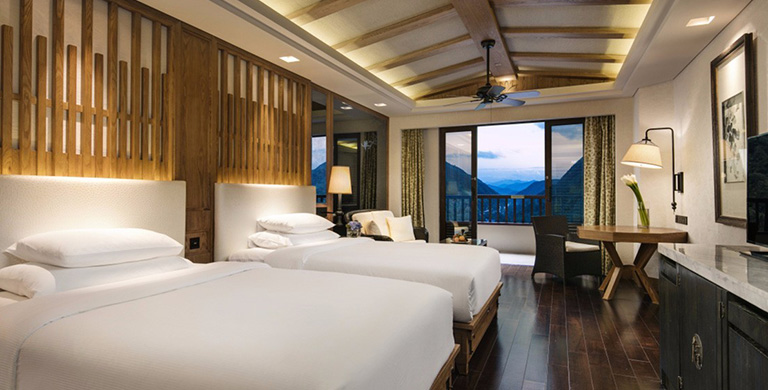 Room in Hilton Sanqingshan Resort Hotel
Room in Hilton Sanqingshan Resort Hotel
©希尔顿官网(hilton.com.cn)
How to Plan a Sanqing Mountain Tour
Since Wuyuan and Wangxian Valley are also located in Shangrao City, most travelers usually choose to go to Wuyuan (about 72 km) to appreciate seas of rape flowers and Wangxian Valley (about 79 km) to embark on a viral fairyland journey before or after Sanqing Mountain.
Apart from that, some travelers would arrange other days to explore other popular tourist spots in Jiangxi, such as Jingdezhen with its profound porcelain culture, Wugong Mountain with its vast alpine meadows, and Mount Lu with its breathtaking waterfalls.
If tourists would like to find out the differences between Sanqing Mountain and Yellow Mountain , they are recommended to proceed to Huangshan City in Anhui which will take about 1 hour by train.
 Porcelain Center Jingdezhen
Porcelain Center Jingdezhen
Travel with China Discovery
Want to hike in Sanqing Mountain but don’t know how to arrange a touring route? Travel Jiangxi with us and all of your concerns will be taken care of. The tour can be tailor-made according to your physical condition, interest, budget, and time.
If you want to extend to other destinations in Jiangxi, you can add them before or after the Sanqing Mountain tour. Our English-speaking tour guide will accompany you all the way, taking care of every detail during your travel. Please feel free to contact us!
Keep Reading
Recommended Tours
Top 3 tours chosen by most customers to explore in the best way. Check the detailed itinerary, or tailor your own trip now with us.

2 Days Wuyuan Autumn Visual Feast Tour
Jingdezhen / Wuyuan

4 Days Yellow Mountain Wuyuan Scenery Photography Tour
Huangshan / Wuyuan
Start planning your tailor-made holiday to China by contacting one of our specialists. Once inquired, you’ll get a response within 0.5~23.5 hours.
Customize a TripHave a question? Get answers from our travel experts or guests
- Your Question:
- Your Name:
- Your Email:
- Submit
Questions & Discussions
Following are latest questions and answers from our webusers and customers. You can learn many useful information from the discussion and cases. You can also join in the discussions or ask your own question. Our experts will help you ASAP.
2. I plan to hike up 1 day from Jinsha and the next following day hike up from Waishuangxi. Then should i buy 2 times entrance fee? Dont the park have a kind of 2 or 3 days entrance tickets?
3. How about the ¥125 round trip cable way fee, is it only for either Jinsha or Waishuangxi??
¥120 entrance ticket is valid for 2 days. You don't need to buy 2 times entrance ticket.
¥125 round trip cable way fee includes one ascending fee and one descending fee (apply both to Jinsha and Waishuangxi). But the cable way ticket is only valid for 1 day. You may need to buy 2 times cable way ticket if you plan 2 days hiking tour.
China Discovery - Your Reliable China Travel Agency

























